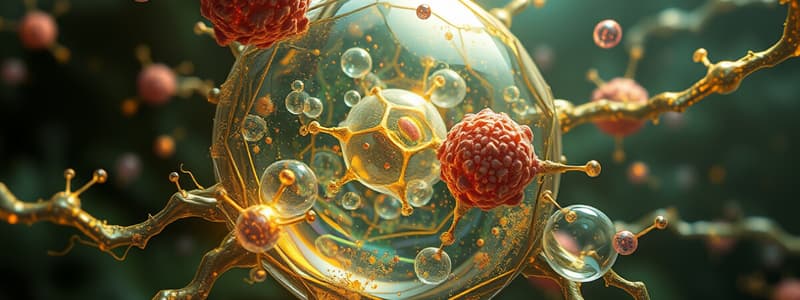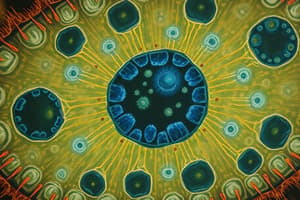Podcast
Questions and Answers
What is a cell?
What is a cell?
The basic unit of life present in all living organisms.
What is the main focus of cell theory?
What is the main focus of cell theory?
- The importance of biotechnology
- The diversity of cellular forms
- The unity of cellular organization in all life forms (correct)
- The physiological processes in living organisms
What are unicellular organisms composed of?
What are unicellular organisms composed of?
- Multiple cells
- A single cell (correct)
- Many different types of cells
- None of the above
All organisms are composed of cells.
All organisms are composed of cells.
What approach enables the description of various biological processes in molecular terms?
What approach enables the description of various biological processes in molecular terms?
Who was G.N. Ramachandran?
Who was G.N. Ramachandran?
Ramachandran discovered the structure of collagen in 1954.
Ramachandran discovered the structure of collagen in 1954.
A multicellular organism is composed of a single cell.
A multicellular organism is composed of a single cell.
What was Ramachandran influenced by during his time at Cambridge?
What was Ramachandran influenced by during his time at Cambridge?
What is the significance of the 'Ramachandran plot'?
What is the significance of the 'Ramachandran plot'?
Study Notes
Biology and Cell Theory
- Biology examines living organisms and their diversity in form.
- Cell theory emphasizes unity among diverse life forms, highlighting cellular organization as a key feature of all living beings.
- Understanding physiological and behavioral processes requires recognizing the integrity of cellular organization.
Physiological Processes and Reductionist Biology
- Investigation of living organisms can utilize a physico-chemical approach via cell-free systems.
- Analyzing living tissues reveals the types of organic compounds present and their functions within cells.
- Key physiological processes include digestion, excretion, memory, and defense, driven at a molecular level by these compounds.
- Abnormal processes in diseases can also be explored through this methodology, termed ‘Reductionist Biology’, applying concepts and techniques from physics and chemistry to biology.
Biomolecules Overview
- Chapter 9 provides a brief description of various biomolecules integral to cellular functions and life processes.
G.N. Ramachandran: Contributions to Structural Biology
- Renowned for his work in protein structure and founder of the ‘Madras school’ of biopolymer conformational analysis.
- Discovered the triple helical structure of collagen in 1954 and developed the ‘Ramachandran plot’ for protein conformation analysis.
- Born on October 8, 1922, in India; his mathematics professor father influenced his academic pursuits.
- Graduated top of his class in Physics from the University of Madras in 1942 and earned a Ph.D. from Cambridge University in 1949.
- Influenced by Linus Pauling's work on α-helices and β-sheets, guiding him towards collagen structure study.
- Passed away on April 7, 2001, at the age of 78.
The Cell: A Basic Unit of Life
- All organisms are composed of cells; unicellular organisms consist of a single cell, while multicellular organisms are made up of many.
- The presence of cells marks the distinction of living organisms from inanimate objects, underpinning their classification as living entities.
Studying That Suits You
Use AI to generate personalized quizzes and flashcards to suit your learning preferences.
Related Documents
Description
Explore the fascinating world of cells in Chapter 8 of Biology. This quiz focuses on the cell theory, the structure, and functions of cells, and the biomolecules that contribute to cellular organization. Test your knowledge on the unity of life forms at the cellular level.




